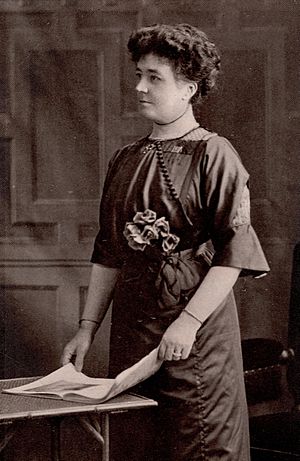Edith Mansell-Moullin facts for kids
Quick facts for kids
Edith Mansell-Moullin
|
|
|---|---|

Edith Mansell Moullin
|
|
| Born |
Edith Ruth Thomas
September 1858 |
| Died | 5 March 1941 London, England
|
| Other names | Edith Ruth Mansell-Moullin |
| Occupation | Social activist, suffragist |
Edith Mansell-Moullin (born September 1858 – died March 5, 1941) was an English woman who worked hard for social change. She was a suffragist, meaning she fought for women to have the right to vote. Edith was very proud of her Welsh background. She even started a group called the Cymric Suffrage Union. This group worked to help Welsh women get the right to vote. She also helped organize a big parade in London in 1911 for women's voting rights. Edith was part of a group of suffragists who took stronger actions. She was even sent to prison for her protests. She continued to speak out, even during World War I.
Contents
Edith's Early Life and Work
Edith Ruth Thomas was born in September 1858. Her parents were Anne and David Collet Thomas. After finishing school, Edith started helping people in poor areas of Bethnal Green, London. She continued this important work even after she married Charles William Mansell-Moullin in 1885. Charles was a well-known surgeon at the Royal London Hospital.
Edith saw many important events that showed her how much change was needed. She saw the Match Girl's Strike in 1888. She also helped dock workers by serving food at a soup kitchen during the London Dock strike of 1889. She kept working to help communities until about 1906.
Fighting for Women's Rights
Around 1906, Edith joined the Women's Industrial Council. She became the head of a committee that looked into workers' issues. About a year later, she joined the Women's Social and Political Union (WSPU). This was a leading group fighting for women's right to vote. She also became the first treasurer for the Church League for Women's Suffrage.
Edith and her husband, Charles, both believed strongly in women's suffrage. Charles was part of the Men's League for Women's Suffrage. Edith was also a member of the Women's Freedom League.
The Great Demonstration
Edith took part in many protests. In 1910, she spoke at a big protest in Hyde Park alongside Emmeline Pankhurst, a famous leader of the suffrage movement.
On June 17, 1911, a huge event called the "Great Demonstration" took place. About 40,000 women marched in London. This parade was part of the celebration for King George V. Edith helped organize the Welsh part of the parade with Rachel Barrett. She encouraged Welsh women to wear their traditional national costumes.
Starting the Cymric Suffrage Union
After the parade, Edith, who was very proud of her Welsh family, started the Cymric Suffrage Union (CSU). The main goal of this group was to get Welsh women the right to vote. While the group was mostly based in London, it also had branches in Wales. Edith traveled to northern Wales to give speeches and promote women's suffrage. The CSU also translated important documents about voting rights into the Welsh language. They shared these documents with Welsh churches.
Protests and Prison
In November 1911, Edith took part in another protest outside Parliament. She was one of about 200 women who were arrested. She was accused of causing trouble and trying to break through police lines, but she said she didn't do it. She was sentenced to five days in Holloway Prison.
After Edith was released from prison, the Cymric Suffrage Union (CSU) was replaced by a new group in October 1912. This new group was called the Forward Cymric Suffrage Union (FCSU) and was more active in its protests. Edith and her husband spoke out against the practice of force-feeding suffragist prisoners who went on hunger strike. Their home became a place where activists met to plan their next steps.
In 1913, Edith became the honorary secretary of a group started by Sylvia Pankhurst. This group worked to get rid of a law called the Cat and Mouse Act. This law allowed prisoners who became very sick from hunger strikes to be released. But as soon as they felt better, they were sent back to prison.
That same year, Dr. Mansell-Moullin, Edith's husband, performed surgery on Emily Davison. Emily was a suffragist who was badly hurt by the King's horse at The Derby horse race. Sadly, he could not save her.
Later Life and Activism
Edith Mansell-Moullin left the WSPU partly because they decided to stop protesting the government during World War I. Edith was a pacifist, meaning she believed in peace and did not support the war. She also felt that people should not stop working for social justice, even during wartime.
She was upset when German mine workers in Welsh mines were arrested, causing their families great hardship. Edith sent appeals to help them and collected money through the FCSU to support these families. She also protested about the low wages paid to women during the war. She asked for public money to help women who were doing relief work.
In 1916, Edith resigned from her roles in the FCSU due to health problems. However, she continued to work on social programs and with groups that promoted peace. In 1931, she led the Society for Cultural Relations with the USSR. She also volunteered at St Dunstan's, a home for blind veterans.
Edith Mansell-Moullin passed away on March 5, 1941, at her son's home in London. This was one year after her husband had died.
Remembering Edith
Edith Mansell-Moullin's name and picture are on the base of the statue of Millicent Fawcett in Parliament Square, London. This statue was revealed in 2018 and honors Millicent Fawcett and 58 other women who supported women's right to vote.

